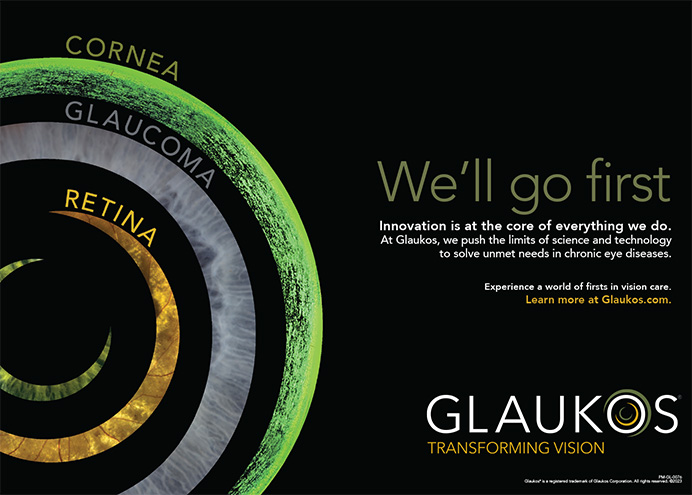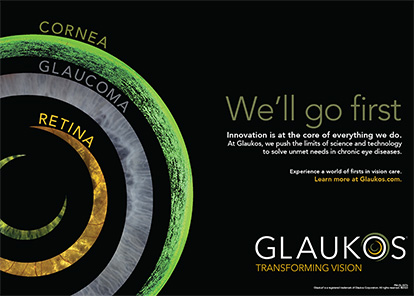Allergic conjunctivitis is classified as a group of diseases affecting the ocular surface, often in reaction to environmental factors. Ocular allergy develops in response to an allergen's binding to a mast cell, thereby releasing stored histamine and other proinflammatory mediators. Allergic conjunctivitis may be acute or chronic. Regardless, its occurrence always creates challenges for a contact lens wearer.
BACKGROUND
Acute forms of ocular allergy include seasonal allergic conjunctivitis and perennial allergic conjunctivitis.1 The former most often occurs during certain months when the amount of dust and pollen in the environment is high. Causes of perennial allergic conjunctivitis include animal dander, feathers, and dust mites. Symptoms of both types of ocular allergy include burning, itching, and watery discharge. Clinical signs are redness, chemosis of the conjunctiva, papillae, and lid edema.
Chronic forms of allergic conjunctivitis include vernal keratoconjunctivitis (VKC), atopic keratoconjunctivitis (AKC), and giant papillary conjunctivitis (GPC).1 VKC is a chronic, bilateral conjunctival inflammatory disorder that typically affects young men.2 Patients present with intense pruritis and copious mucus secretion, giant papillae (cobblestone) in the upper tarsus, and gelatinous nodules around the limbus (Tranta dots).3 Clinical signs are evident in the upper conjunctiva and include papillary hypertrophy, subepithelial fibrosis, fornix foreshortening, symblepharon, corneal ulceration, and neovascularization.4 The most severe complication of VKC is vision loss secondary to corneal involvement.
AKC is a severe chronic inflammatory disease of the conjunctiva that often occurs in patients with atopic disease and eczema. Ocular symptoms include intense ocular itching, photophobia, burning, and foreign body sensation.4 Unlike in VKC, the clinical signs of AKC are typically more prominent in the lower conjunctiva. Similarly to VKC, however, keratopathy is the main cause of visual impairment in AKC as well.
GPC is a chronic allergic response commonly seen in contact lens wearers. The pathophysiology is thought to be related to contact lens solutions or deposits on the contact lens that act as allergens.3 Ocular itching after the lens removal, increased mucus discharge in the morning, photophobia, and decreased lens tolerance are common symptoms.4
Complications
Patients with allergic conjunctivitis who wear contact lenses present unique complications because the two conditions often exacerbate each other. Contact lenses often worsen allergic symptoms, and allergic inflammation, in turn, alters the comfort of, fit of, and vision provided by the contact lenses.
Dry eye disease is a known consequence of contact lens wear for myriad reasons. A contact lens on the ocular surface divides the tear film into two layers, which increases evaporation and tear osmolarity. The resulting dryness raises the amount of inflammatory debris in the tear film, which can aggravate allergies.5 A reduced blink rate, common among contact lens wearers, further increases the rate of tear film evaporation. Furthermore, the specific water content of soft hydrogel materials may cause the contact lens to absorb tears from the ocular surface.
Most contact lens wearers blink incompletely, which could decrease meibomian secretion and destabilize the tear film. When the tear film is inadequate, proteins and lipids are able to build on the contact lens, and the allergic cascade worsens. GPC is the manifestation of allergies in response to protein deposition on the contact lenses.
Allergic symptoms can also make contact lens wear more challenging. Chemosis, injection, papillae, follicles, epiphora, and itch can all cause the lens to feel uncomfortable. Excessive epiphora or an unstable tear film may result in poor vision and a poor fit. Papillae and follicles also interfere with the lens' fit when lid interaction plays a significant role in the lens' centration and movement.
Management
Our management of symptomatic contact lens wearers begins with the ocular surface. We treat meibomian gland dysfunction and blepharitis with an aggressive nightly regimen of warm compresses, lid scrubs, and azithromycin ophthalmic solution (AzaSite; Merck & Co., Inc.) applied to the base of the eyelashes. We seek to control the signs and symptoms of dry eyes with a combination of cyclosporine ophthalmic emulsion 0.05% (Restasis; Allergan, Inc.), unpreserved artificial tears, and oral omega-3 fatty acid supplements. For recalcitrant meibomian gland dysfunction, daily oral doxycycline (50 mg) may be necessary.
Specific allergic symptoms can be kept in check with a tiered approach that is based on the severity of patients' symptoms. For many, the temporary discontinuation of contact lens wear will rein in allergic symptoms. We address persistent mild or acute allergic conjunctivitis with the use of cold unpreserved artificial tears and a short course of topical over-thecounter vasoconstrictors such as naphazoline hydrochloride (Vasocon; Novartis Ophthalmics, Inc.) and naphazoline-pheniramine (Naphcon-A; Alcon Laboratories, Inc.). Moderate to severe conjunctivitis or chronic conjunctivitis often requires combined antihistamine-mast cell stabilizers (olopatadine [Pataday; Alcon Laboratories, Inc.], bepotastine besilate [Bepreve; Ista Pharmaceuticals, Inc.], and alcaftadine [Lastacaft; Allergan Inc.]), topical corticosteroids (loteprednol etabonate), and oral antihistamines (diphenhydramine, cetirizine, loratadine, fexofenadine). 6 It is important to note that caution, education, and timely follow-up are imperative for contact lens wearers who are prescribed topical steroids.
To minimize protein buildup on contact lenses, we often switch patients to single-use disposable or silicone-hydrogel lenses with a frequent replacement schedule. A preservative-free contact lens solution, such as Clear Care (Alcon Laboratories, Inc.), is essential for eliminating solution-related toxicity as well as thoroughly removing proteins and lipids from the surface of the lens. Furthermore, because rigid gas permeable materials are typically more resistant to deposits, some allergy patients prefer these contact lenses to soft lenses.5 Gas permeable scleral lenses have been found to be an effective strategy for the management of severe ocular surface disease. The moisture chamber created by the scleral lens may offer relief to patients with concomitant dry eye symptoms. In individuals with significant keratitis secondary to palpebral papillae and follicles, scleral rigid gas-permeable lenses may serve as a protective shield for the cornea, thus creating a barrier between the ocular surface and the papillae under the eyelids.
CONCLUSION
For patients with severe symptoms, the long-term discontinuation of contact lenses may be necessary to obtain relief from their symptoms. Spectacles and refractive surgery have helped many patients with refractive errors minimize their allergic symptoms.
Rajesh K. Rajpal, MD, is the medical director of Cornea Consultants, PC, in McLean, Virginia, and a clinical associate professor at Georgetown University Medical Center in Washington, DC. Dr. Rajpal is a consultant to Allergan, Inc.; Inspire Pharmaceuticals; and Ista Pharmaceuticals, Inc. He is also a speaker for Alcon Laboratories, Inc., and Bausch + Lomb. Dr. Rajpal may be reached at (703) 287-4122; rrajpal@seeclearly.com.
Natasha Randhawa is a fourth-year optometry student at the Pennsylvania College of Optometry at Salus University in Elkins Park. She acknowledged no financial interest in the products or companies mentioned herein.
Christine Burris Wisecarver, OD, is the optometric director at Cornea Consultants, PC, in McLean, Virginia. She acknowledged no financial interest in the products or companies mentioned herein. Dr. Wisecarver may be reached at (703) 287-4123; cwisecarver@seeclearly.com.
- 1. Ono SJ, Abelson MB. Allergic conjunctivitis: update on pathophysiology and prospects for future treatment. J Allergy Clin Immunol. 2008;115(1):118-122.
- 3. Siddique M, Manzouri B, Flynn TH, Ono SJ. Allergy and contact lens. Chem Immunol Allergy. 2007;92:166-175.
- 4. Bonini S. Atopic keratoconjunctivitis. Allergy. 2004;59(78):71-73.
- 5. Asbell PA, Lemp MA. Dry Eye Disease: the Clinician's Guide to Diagnosis and Treatment. New York; NY: Thieme Medical Publishers Inc; 2006.
- 6. Bielory BP, O'Brien TP, Bielory L. Management of seasonal allergic conjunctivitis: guide to therapy [published online ahead of print November 8, 2011. Acta Ophthalmol. doi: 10.1111/j.1755-3768.2011.02272.x.


